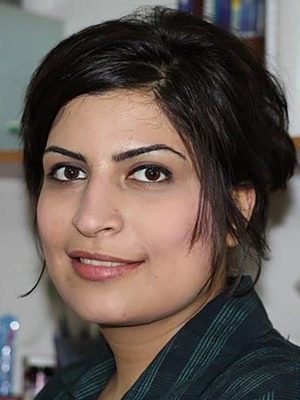
Najme Ebrahimi
University of Michigan – Ann Arbor
Postdoctoral Researcher
Najme Ebrahimi is a postdoctoral research fellow at the University of Michigan, Ann Arbor, MI, since September 2017, where she is mainly conducting research on scalable phased arrays, high data rate communications for 5G and 6G systems, and secure and low-power techniques for the next generation of distributed wireless Internet-of-Things (IoT) connectivity and communications. She received her PhD from the University of California San Diego in 2017, with an emphasize on enabling high data rate and scalable mm-wave phased array for the next generation of wireless systems. She also received her MS degree, with highest honors, from Amirkabir University of Technology (Tehran Polytechnique) in 2011, with thesis emphasize on low-power low-resolution electronic interface for capacitive sensor interface. She received her BS degree from Shahid Beheshti University, Tehran, Iran, in 2009, with highest honor, awarded her university fellowship for graduate studies. She is a member of IEEE Solid-State Circuits, IEEE Circuits and Systems, and IEEE Microwave Theory and Techniques societies. She is currently serving as the vice chair of IEEE Southern Michigan for Microwave Theory and Techniques Chapter. She is selected as 2019 EECS RisingStars.
Research Abstract:
Wireless communication is seeing an exploding demand and, consequently, the immediate response of wireless world is development of 5G for cellular networks. To achieve high data rate communication acquiring mm-wave (MMW) wireless band (30 GHz–300 GHz) is inevitable. The major challenge of deploying systems at MMW or THz frequency bands is the channel fading and multi-path diffraction effect. Hence, multiple-element transceivers such as scalable phased array or massive MIMO are required. To overcome these challenges I proposed novel solutions including: a) parasitic-insensitive, power-efficient and wideband 2×2 arrays of injection locked oscillators for frequency synchronization and beamforming, removing the noisy and lossy phase shifter required at each scalable element, b) bidirectional and compact transceiver architecture to meet the antenna array spacing requirement at MMW, and c) a compact aperture coupled differential LO and IF distribution technique and a wideband aperture coupled antenna array for scalable implementation of antenna-IC packaging.
Furthermore, to achieve wideband communications with high order modulations envisioned for 5G (10Gb/s) and 6G (100Gb/s) generating the wideband LO quadrature signal is necessitated. Consequently, this requires high order equalization and power hungry calibration circuitry at each element of a scalable array. To this end, I proposed the first image selection sliding-IF Weaver architecture at MMW, reducing the LO tuning range bandwidth from a conventional 20% for MMW (above 60 GHz) system to only 4%. In other words, the proposed image selection architecture makes the two upper and lower band of MMW as images of each other, doubling the bandwidth and capacity of the system.